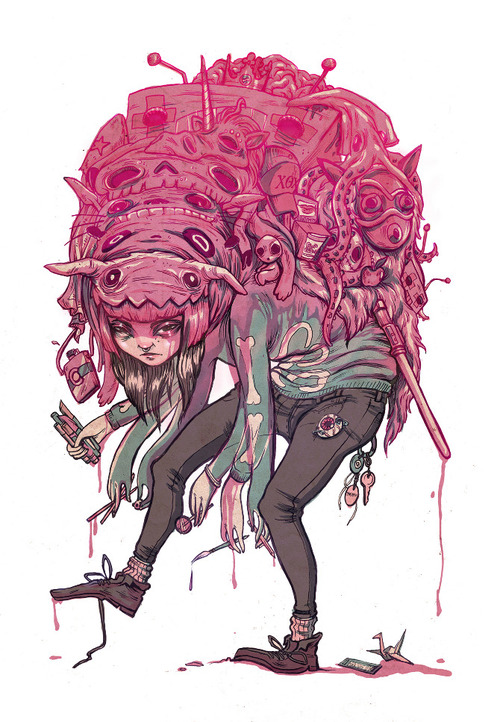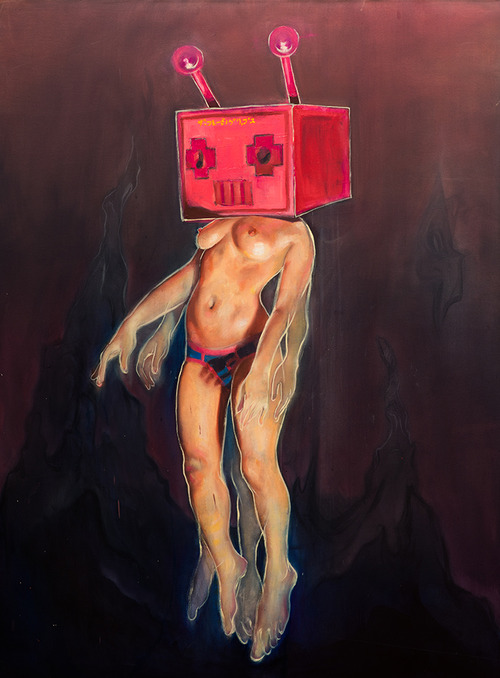Lawrence Neil, Katharine Schwab, and Alec Arceneaux of the Stanford Arts Review sat down with artist Lauren Youngsmith ’13 to discuss her art, her recent project with the Flaming Lips, and getting Stanford to pick up the tab.
Stanford Arts Review: We checked out your exhibit (which you can view at laurenys.com). Do you think your work is largely autobiographical?
Lauren Youngsmith: It’s definitely very hedged in my personal visual vocabulary, and I’m trying to make it more universal, because a lot of it is based in my daydreams, my form of escapism. So I realized it’s hard for people to access it personally; it’s easy to look at my work and say “Oh, that’s cool” and just walk on. So I’m trying to break out of that a little bit. I think I’ve just been trying to accumulate these images and use them as parts of my vocabulary until people recognize them as mine.
I’ve always really like Japanese visual culture more than Chinese visual culture, which is weird, because I am Chinese. Which explains all of the geishas. I’ve been looking at Asian fashion recently, the communication between ancient Asian fashion and contemporary.
Your work is filled with monsters. Do you have favorite horror movies?
Yeah, definitely! I love Asian horror films. The Host. Sea monsters in general. Battle Royale. That’s not really monsters, just kids killing each other. I like the monsters in Where the Wild Things Are. Not a lot of movies scare me. The ones that scare me are the ones that are invisible, like Paranormal Activity. I just appreciate a good monster design. A good combination of animals, you know. None of them really scare me, though.

What would you say is your “artist statement” for this gallery?
Well, it’s hard, because it’s a retrospective, and very expansive, so it’s hard for me to just come out and say “Lauren Youngsmith’s work is about this.” But I was getting into the idea that my artwork is about interrogating the escapist impulse. The reason a lot of us are exploring art or creative writing is that we’re escapists, and are thinking about our roles. I’m constantly doing that; that’s why I have all these masks and costumes in my work. I think there’s still a lot to shake out of that.
What was it like to have your sketchbooks on display at the gallery? They seemed very personal.
Totally weird. Because the stuff I care about most is in my sketchbooks. I would never just lay them out for people to see them. That’s really scary to me. That’s why I made the video [of my hands flipping through the sketchbooks], to allow people to just watch it as one piece. For some reason that allowed me to divorce myself from the physical object; it’s not the thing i’ve been holding in my hands all summer, it’s an art piece that could be anyone’s.
The thing about my sketchbooks is that I remember exactly where I was when I drew each piece, and what they all mean to me. There’s a lot of really personal stuff in there, stuff about my ex-boyfriend, stuff from my travels, and I feel kinda brave throwing that up on a wall. But it did make me squeamish. If you noticed, there were some pages that got skipped [laughs].
What’s it like working with pen instead of pencil?
It’s awesome! I love ballpoint pens. My best advice for someone who’s starting as an artist and is worried about messing up is that there’s no such thing as a mistake. If you mess something up, just… well, wait, there definitely is such a thing as messing things up. But it’s your sketchbook, that’s the place for it. It’s the equivalent of turning off your monitor and just typing.
Who are some graphic novelists you admire?
I love Craig Thompson. I always have. I think his stuff is kinda girly, but the line quality in his work is great. Blankets is the first graphic novel I ever read. And Habibi is just… it literally is too much. He’s a really good storyteller.
So can you tell us a bit about your artistic background, and why you chose to come to Stanford?
It’s weird, I’ve been thinking about that a lot lately. I went to a high school that’s actually a lot like Stanford. Very liberal-artsy. The art program was very freeform. I think I was just bored with everything else I was doing, so I was very prolific with my art. I had a teacher who got me into graphic novels when I was a freshman, and she was a huge source of support for me. It just seemed like what I was going to do when I graduated.
I was pretty sure I was going to go to an art school on the East Coast, but then I got into Stanford. For some reason I was just really drawn to the culture here, even though I knew I wouldn’t really be supported by the art program here, which remains true today. That was something I was used to. But having an art program that has tons of resources is really amazing. I’ve never had to pay for art supplies here. And it’s a very malleable program, it’s still growing. I felt very fluid moving around the program, getting what I wanted out of it, even though there wasn’t much rigor to it. The graphic novel project was a huge reason I came.
It’s hard to look at, and be aware of, all the opportunities you got from being at one place, but I got an internship at Dreamworks this year, I got in touch with the Flaming Lips because I was in this area. I think I got a lot from being in this community. So you just have to look at everything holistically. I’ve been doing a lot of reflection on it. It’s like a weird, contentious thing; being an art major here.

Can you talk about how you got commissioned to make a comic book for the Flaming Lips?
Sure! I met them in 2010. I’d been going to their shows since I was a teenager, wearing this robot head thing, carrying around a bunch of art. My friends would say, “What are you doing?” “Oh, you know, just going to a concert.” Get a twitter, that’s my advice. I follow [singer] Wayne Coyne and he posted pictures of his wife. I recognized her when she approached me and asked if she could get a picture of me, so I asked if I could get on stage. I met Wayne afterwards, and I showed him all my sketchbooks, and he said “here’s my number! here’s my address, send me some art!” Which is not something normal people would do, I guess. So I’m lucky in that sense. He’s very fluent in social media.
Years passed, he would send me pictures of crazy stuff, like “what up!” He would always say to me, “You’re an artist, what are you gonna do?” I said, “I dunno, I like graphic novels, and drawing comics.” So I guess he thought about it, and last summer he said “I want you to make us a comic.” I said “yeah totally.” So he gave me this wacked-out premise, and total free reign, and just asked for updates. That kinda consumed my summer. I was really nervous about how it was going to be. When you get an offer like that, you think to yourself, this could be my break. So I eventually just busted it out and brought it to them. It should be printed soon. Wayne also has his own comic, which is really cool, and weird.
Was that your intention when you set out to meet them?
I mean, I don’t want to make Flaming Lips art for the rest of my life. But there’s something about a band that’s totally formulated around its own vocabulary, and its own mythology. Each of their songs tells a story. And then there’s this crazy live experience. I’ve been trying to figure out a way to make my art performative, because that’s the part that it’s missing. Right now it’s so lonely and myopic. There’s something about sharing this over-the-top, confetti’d experience with some random freaks from Oklahoma that I wanted to pursue. It was just a pipe dream, but now it’s become, “How do I channel that energy into my own art, and make people see my art that way?”
What do you want to do next?
I’m working at 826 Valencia this summer, doing creative writing with kids. I’m going to work on my visual development portfolio, send it to some animation studios. I think I’m just trying to put art and storytelling together. In my own way. I realized that I really hate doing comics. I just got so tired of it, it’s bad.
You’re not gonna do the sequel?
Well, if they ask me, of course! [laughs]
The question is, “How do I warp the medium so that I like it better?” It seems perfect, it’s just writing and art together, after all. And there are tons of people doing crazy avant-garde graphic novels that bust the medium open. My ideal career path would be something like [Hiyao] Miyazaki. That stuff just blows my mind.
Did you write the story?
I basically wrote it myself. It’s kind of a spinoff of Greek creation myth. Mostly it’s just like, stuff happening! Literally the story idea that Wayne gave me was “We find god! And we cut his head open! And we take out a brain! And then we take out the center and carry it with us in a jar! And…”
Is that how Wayne Coyne talks?
Well, it’s over text, and it has like a million exclamation points. I’ve only really hung with him once, the whole band came to Theta Chi. They’re really weird guys.
What are some classes you would recommend to fellow students?
Take the graphic novel class with [professor and StAR advisor] Shimon [Tanaka]. You wanted me to say that, didn’t you? Take animation. It’ll kick your ass. Hardest class I’ve taken at Stanford. Get art grants as much as you can. There’s no reason you should pay for anything while you’re here. If you can find the time to do some crazy project, someone will pay for it for you. Ask your professors, that’s how I got my internships. The teachers in the art departments always have stuff going on.
Lauren Youngsmith graduated from Stanford in 2013. She’s originally from Denver, Colorado. Explore her work at laurenys.com.
Image credit: laurenys.com

